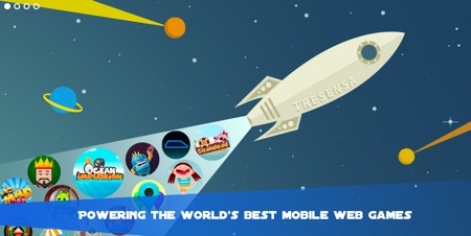New York City-based TreSensa is an unashamedly quiet developer that, as a result, has slipped under the radar for many.
In fact, it's regularly referred to as 'the biggest mobile gaming company you haven't heard of'.
An ambitious claim, but TreSensa has a profile to back it up. Amazon, HBO, AOL, DeNA, Kik and others have all turned to the studio to harness its HTML5 expertise, and TreSensa boasts 1 million users on its own distribution platform.
We caught up with TreSensa's founder Rob Grossberg recently to discuss HTML5, its future in the industry, and what it is about the language that makes it so appealing to major brands.
Pocket Gamer: With the current trend of free-to-play dominating the App Store, there's no barrier to entry for many players. Why develop HTML5 apps instead of free-to-play native apps?
Rob Grossberg: By building in HTML5, you have the opportunity to distribute your game to the widest possible market on mobile.
That includes distribution through all existing and emerging game distribution channels like mobile web game sites, on game sections of major mobile media sites, and within the growing set of alternative game stores from Amazon, Mozilla, and Tizen.

It also includes within the game marketplaces being introduced by all major phone carriers, within mobile messaging apps like Kik or Tango, on Facebook and Twitter, and within the Apple App Store or Google Play.
We believe that it does not need to be an either-or proposition. The Apple and Google app stores are good channels for distributing a mobile game, but by no means should they be your only channel.
How do you handle the issue of discovery with HTML5 apps? Are there any channels which are more - or less - efficient?
The beauty of a mobile web game is that you are not handcuffed by any one discovery method or strategy.
We are seeing millions of game plays each month from people just searching for games through their mobile browser and finding them on sites or portals that are distributing games built on TreSensa.
The best part of this discovery is that it happens with no cost to the developer or studio.
There are already thousands of sites and apps out there on the web that have audiences in the multi-millions. What those properties and users are looking for is engaging game content that does not have to live within the walled gardens or Apple and Google.
What monetisation opportunities exist for HTML5 apps that aren't available for native iOS or Android games?
Since HTML5 games can be distributed outside of the native app stores, they have the freedom to monetise in ways a standard desktop website might.
For example, through the mobile web you can support in game purchase of physical goods, something the IOS app store would not allow.
How could this work? One example would be to build a branded game around some entertainment IP and allow the users to unlock a promotion through game play, such as the ability to instantly purchase a DVD associated to the brand at a discounted rate.
Tying mobile game achievements to incentives to purchase actual - not just virtual - goods is the next step in the evolution of mobile game monetisation.
User acquisition is something that all games need to eventually struggle with. What benefits - if any - does HTML5 offer for UA over games that exist on an app store?
HTML5 games offer huge benefits around user acquisition over the native app stores.
The portability of HTML5 games allow them to go to the user rather than driving the user to the point of download - the app store.
Games can be found and played through browser search or within a set of mobile game portals or game pages where your game is one of a few hundred, rather than one of 200,000. And these game plays come with no cost per acquisition.
As UA continues to skyrocket within the app stores, the value of reaching users through the mobile web will only increase.
Many developers are looking at emerging markets for untapped business opportunities, how does HTML5 fit into this picture and is it prepared to deal with unbanked players in developing nations?
Africa and India are two markets that TreSensa is most excited about.
In Africa, there has been significant growth in smartphone adoption over the past several years. There is also a significant portion of the population with disposable income who would like to transact within games.
What they do not have are credit cards, so the app store economy does not work well in this geography. TreSensa, however, recently partnered with an African game portal that works with the various African phone carriers such that freemium games built on TreSensa tie directly into local carrier billing when being played in Africa.
In India, feature phones are rapidly being replaced by Android-based smartphones, thus opening up mobile gaming to 1.24 billion potential new players. And like in Africa, carrier billing or other non-credit card ways to pay are now starting to emerge.
The key to truly tap the India market, we believe, is to create localized content.
Why are major brands like Progressive Insurance and HBO now looking to mobile web games as the ideal way to connect with and engage users on mobile?
Brands are struggling with ways to connect with users on mobile.
Video ads feel very intrusive on a phone, and banner ads are not all that effective. What brands need to do is engage with their mobile users in way that resonates with users - namely, mobile games.
Over 40 percent of people's time spent on mobile devices is spent playing games and on just tablets, that percentage rises to 67 percent. Games are clearly the 'killer' content on mobile.
The challenge to date for brands has been that the only way to get games on mobile was by producing native games.
That is an expensive proposition, especially when it requires producing both an IOS and Android version. In addition, the download requirement in the app stores is a huge hurdle for a branded game.
People are just not very likely to download a branded game unless they are heavily incented to do so and that costs money.
Enter mobile web games. Mobile web games can be produced in a fraction of the time and cost of a native game and can be shared directly by the brands through their existing social platforms like Twitter and Facebook - again, just a click of a link with Twitter or Facebook on mobile or desktop.
As an example, last summer HBO produced a mobile web game for season 6 of its True Blood franchise and used it to engage the True Blood fan base within its existing Facebook and Twitter channels.
Thanks to Rob for his time.






















